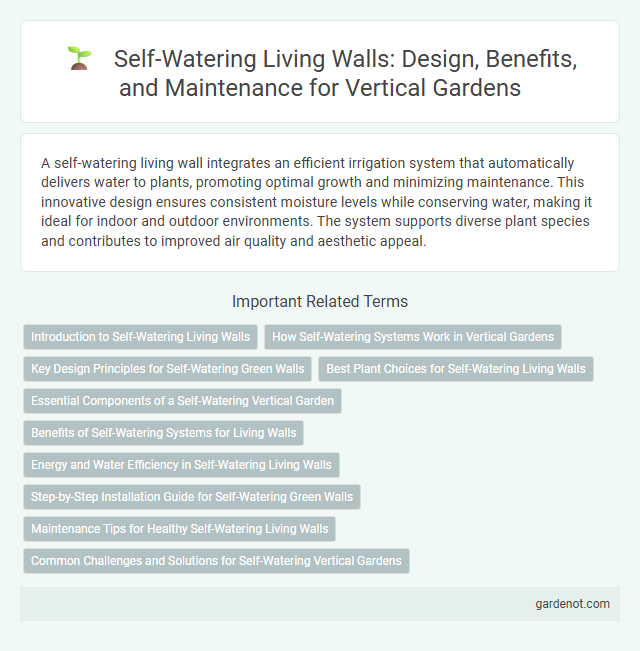A self-watering living wall integrates an efficient irrigation system that automatically delivers water to plants, promoting optimal growth and minimizing maintenance. This innovative design ensures consistent moisture levels while conserving water, making it ideal for indoor and outdoor environments. The system supports diverse plant species and contributes to improved air quality and aesthetic appeal.
Introduction to Self-Watering Living Walls
Self-watering living walls integrate automated irrigation systems that deliver water directly to plant roots, reducing maintenance and ensuring optimal hydration. These vertical gardens use capillary action or integrated reservoirs to supply consistent moisture, enhancing plant health and longevity. Energy-efficient and sustainable, self-watering living walls improve indoor air quality while conserving water resources.
How Self-Watering Systems Work in Vertical Gardens
Self-watering living walls utilize an integrated irrigation system where water is distributed evenly through a network of tubes or wicks embedded behind the plants. This system ensures consistent moisture levels by using a reservoir that supplies water via capillary action or gravity, reducing the need for frequent manual watering. Sensors or automated timers often optimize water delivery, promoting healthy plant growth and minimizing water waste in vertical garden installations.
Key Design Principles for Self-Watering Green Walls
Key design principles for self-watering living walls include efficient water distribution systems that ensure uniform hydration across all plant layers, preventing both overwatering and dry spots. Integration of moisture sensors and automated irrigation controls optimizes water usage by adjusting supply based on real-time plant needs and environmental conditions. Selection of appropriate substrate material with high water retention and drainage capabilities enhances root health while maintaining structural stability of the wall.
Best Plant Choices for Self-Watering Living Walls
Succulents, ferns, and pothos thrive in self-watering living walls due to their low water requirements and adaptability to consistent moisture levels. Spider plants and peace lilies also perform well, benefiting from the steady hydration system without risk of overwatering. Selecting drought-tolerant and moisture-loving species ensures vibrant, healthy growth in automated irrigation setups.
Essential Components of a Self-Watering Vertical Garden
A self-watering living wall incorporates essential components such as a water reservoir, a wicking system or drip irrigation, and a moisture-retentive growing medium to ensure consistent hydration of plants. An integrated water distribution system efficiently delivers moisture to the plant roots, minimizing the risk of overwatering or drought stress. Durable waterproof backing and a sturdy frame support the structure while preventing water damage to the wall surface.
Benefits of Self-Watering Systems for Living Walls
Self-watering living walls provide consistent moisture levels, promoting healthier plant growth and reducing the risk of overwatering or underwatering. These systems enhance water efficiency by using automated irrigation that minimizes waste, making them ideal for sustainable urban environments. The reduced maintenance requirements allow for easier care, supporting vibrant and thriving green walls with minimal manual effort.
Energy and Water Efficiency in Self-Watering Living Walls
Self-watering living walls utilize integrated irrigation systems that minimize water waste by precisely delivering moisture to plant roots, significantly reducing overall water consumption compared to traditional watering methods. These systems often include sensors and automated controls that optimize water use based on environmental conditions, enhancing both water and energy efficiency. By lowering the need for manual watering and reducing water runoff, self-watering living walls support sustainable urban landscaping and contribute to energy savings in building maintenance.
Step-by-Step Installation Guide for Self-Watering Green Walls
Installing a self-watering living wall involves mounting a sturdy frame, securing a waterproof backing, and attaching modular planting pockets filled with soil and selected plants. Integrate an automated drip irrigation system connected to a water reservoir or plumbing to ensure consistent moisture delivery without manual watering. Regularly check the water level and system performance to maintain healthy plant growth and prevent root rot in the vertical garden.
Maintenance Tips for Healthy Self-Watering Living Walls
Regularly check the water reservoir to ensure it remains adequately filled, preventing plant dehydration in a self-watering living wall. Inspect the irrigation system for clogs or leaks to maintain consistent moisture levels essential for plant health. Clean the plant trays and prune dead foliage to promote air circulation and reduce the risk of mold or pests.
Common Challenges and Solutions for Self-Watering Vertical Gardens
Self-watering living walls often face challenges such as uneven moisture distribution, root rot, and algae growth due to overwatering or poor drainage. Implementing a well-designed irrigation system with sensors ensures consistent water delivery and prevents waterlogging. Using moisture-retentive substrates and selecting drought-tolerant plants further enhances water efficiency and reduces maintenance needs in vertical gardens.
Self-watering living wall Infographic

 gardenot.com
gardenot.com